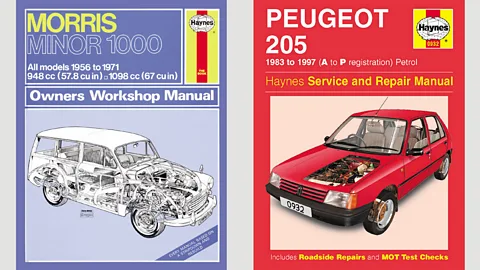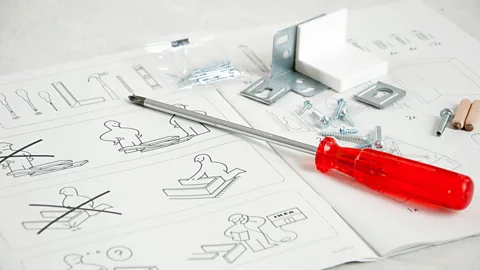Inside the world of instruction manuals
 Getty Images
Getty ImagesSome user manuals are a frustration, some are a pleasure – and all reveal more about us than we might think.
Maybe you diligently read an instruction manual from cover to cover before you even turn on a new product. Or perhaps you ‘file’ the information in the kitchen drawer never to be found again – preferring to rely on instinct (and perhaps a degree of stubbornness) in assembling a new piece of furniture. Either way, and even if it’s only months after your purchase, there is almost always a time and a place when instruction manuals come in handy.
While we may think of them as the dense paper booklets that fall out in a tumble of bubblewrap and polystyrene when we are unpacking our new bedside cabinet, instruction manuals are much more. They exist for a multitude of purposes and take many different forms. What’s more, they are not an especially modern invention: they have, in fact, been around for at least two centuries.
“Wherever you are in life, there's always a manual somewhere, hidden behind the scenes,” says Paul Ballard, Managing Director of 3di, a company that specialises in technical writing.
You might also like:
• The useless design features in modern products
More than just a practical how-to list, instruction manuals can reveal much about the time and society in which they were written. How they have evolved tells us about how we’ve changed too.
According to Roger Bridgman, a former curator at London’s Science Museum, “instructions are there to compensate for the inabilities of machines by employing the abilities of users, and therefore tell you something about the state of both at the time they were produced.”
The earliest instruction manual that Bridgman found during his tenure was attached to a machine made by famous engineer James Watt. But the machine wasn’t a steam engine: it was an office copier. Watt realised that copies of his letters would be very useful to others and so he invented a machine that transferred damp ink from a freshly written letter to another sheet of paper, creating a copy of it.
The instructions included are in their most basic form. They say to take a sheet of paper, put it on top of the other sheet of paper. Put the felt blanket on top. And put it through the rollers.
“As James Watt was a very practical man, the instructions are not a booklet,” Bridgman told a 2009 BBC radio documentary, How to Write an Instruction Manual. “They are actually a sheet of paper glued to the machine so you can’t lose them – a rule that modern manufacturers could do well to emulate.”
 Getty Images
Getty ImagesIn fact, for Ballard, Watt’s instructions exemplify a successful manual’s fundamental principles. The first is “findability”: making it easy for people to find the information they need, whether that means being able to find the manual itself by putting it in an obvious location or having an intuitive structure that has anticipated the way the reader thinks about their problem.
The second is making the instructions easy to understand. “Clarity will win every time,” says Ballard. Simplicity and directness in both language and design is key.
The final rule? “Get out of the way,” Ballard says. This means making sure people know what to do next when their particular need has been met – whether that is finding out something else or cracking on with using the product.
This, Ballard jokes, is why instruction manuals face an “existential crisis”. “The whole point is the product, not the manual; the more you're spending time looking at the manual, the less you're getting out of the product.”
Top tips
Not every manual today is as simple and elegant as Watt’s. But there is a resurgence of manufacturers applying this same idea of integrating the instructions into the product itself. This could take the form, for example, of a big label of instructions on the side of a generator, or a help file that pops up in the same generator’s control panel.
 Alamy
AlamyAnother exemplary early manual is that for the Kodak Box Brownie camera, one of the earliest cameras produced. “The document is very beautiful. It tells you how to load the film but it also gives you advice about how to take a picture,” Mark Miodownik, director of the Institute of Making at University College London, told the BBC back in 2009.
Along with detailed technical information for operating the camera, there is guidance on how to take good photographs, from capturing the optimum portrait to considering the effect of the weather (from “bright sun” to “cloudy dull”) or even how light or dark an interior wall colour is.
 Harry’s
Harry’sHarry’s is an example of a modern brand adopting the same approach of talking to its customers not only about how to operate its products, but how to get the most out of them – in this case, proffering tips on the perfect shave.
Creating this more personal connection through the instruction manual makes good business sense. If consumers are made to feel good about the product they have bought, they are more likely to feel favourably towards the brand in future.
Meanwhile, the visually striking Haynes car manuals are instantly recognisable and strangely evocative. Even for those who have never so much as got their hands dirty with car oil, Haynes manuals are redolent of a certain era (for me, the 80s and my own father’s slightly grubby Ford Cortina manual on the shelf in the garage). As the company’s strapline has it, Haynes “shows you how”.
 Haynes Publishing
Haynes PublishingFor more than 50 years, Haynes has provided high quality technical advice in a manner that is easy to understand and practical to use. The company’s manuals are “like a travel guide to a foreign land – it makes the unfamiliar manageable”, as Martin Love, motoring editor at British newspaper Observer, describes it.
What is it about the Haynes’ approach that makes it so effective? The company uses a practical combination of highly detailed technical drawings showing component parts and in-depth instructions on testing, repair and maintenance, accompanied by photographs.
Haynes was founded in 1960, after John Haynes wrote and published his first book on building an Austin 7 Special. The first ‘proper’ Haynes Owners Workshop Manual, for the Austin Healey “Frogeye” Sprite, was published in 1966.
At the time, instruction manuals were formal and written by manufacturers in very technical language. “I was very fortunate to find, as they say, a gap in the market. A huge gap, I later found out,” Haynes told the BBC back in 2009.
 Haynes Publishing
Haynes PublishingDespite staying true to its original style, Haynes has moved with the times and now publishes a vast range of nearly 2,000 manuals across a diverse array of topics. From pet care to computers and from music to sci-fi, there are even tongue-in-cheek guides to the English and to the inner workings of Teenagers.
Look books
Some manuals have got rid of words almost altogether – as at Ikea, the Swedish homeware giant. Some say that Ikea’s wordless instructions make assembly of its furniture as easy as it can be, while others are flummoxed by the company’s famous pictograms. At the very least, though, they help the company avoid the cost of translating instruction into multiple languages.
Ikea’s instruction manuals were internationally recognised when they won the 2015 Paul Mijksenaar Design for Function Award. As Paul Mijksenaar, the visual design expert behind the award, put it: “Ikea has managed to create an almost unparalleled, consistent and beautifully executed oeuvre. An oeuvre that, rather than being merely recognisable, has proven to be effective for more than 30 years”.
 Getty Images
Getty ImagesSo why do we sometimes struggle so much with Ikea’s manuals? According to Ballard, “it's not because the manual itself is poor. It's because the product itself is too complicated. Ikea manuals start fundamentally with the product. The manuals which are least popular are the ones where the product itself has fundamentally not quite been designed to its best.”
The fact that Ikea manuals have the constraint of simple black and white two-dimensional illustrations forces the products themselves to be better designed to ensure straightforward assembly.
Outside of Ikea, many products are getting more complicated to assemble or use. And that means more complicated instructions. But that, too, may be changing. “The abilities of machines have increased so greatly that users can connect to them without much instruction – and much of what is needed can be provided in real time by the machines themselves,” says Bridgman.
“Often products don't have manuals – either because the product has been designed so well so that you never need to know how to do anything with it, or you're 'not allowed' to get under the bonnet and do anything with it,” says Ballard. “I think that's a major shift: that people don't expect to have to do anything with the product anymore.”
Apple’s iPhone, for example, is purposefully difficult to tinker with.
One aspect of instruction manuals that seems unlikely to go away any time soon is that they must now include health and safety guidelines. They may seem superfluous to some users, but reflect the manufacturer’s responsibility to keep people safe when operating their product.
Another factor affecting how instruction manuals have evolved is globalisation. Companies frequently distribute their products to markets around the world, necessitating translations of the instructions into sometimes dozens of languages. Unless care is taken, this can result in confusion or frustration for the end user – and reflect badly on the brand.
How consumers use manuals also has changed. They used to be solely reference guides that would accompany a product. Increasingly, however, people will refer to a product’s instructions to check out its technical specifications in advance of buying: the manual now is part of the purchase process.
 Getty Images
Getty ImagesAnd, of course, the format of instruction manuals has changed. Today they can just as easily be a YouTube video demonstrating the different functions of a buggy or a dedicated website to help businesses understand a complex new phone system or a user-generated online guide to fix a glitch on a troublesome smartphone. There also has been a move in recent years, enabled by web-based technology, for users themselves to create and share instruction manuals. Ifixit.com, for example, is “the free repair guide for everything, written by everyone.” As of March 2018, it offered 37,192 free manuals and, 122,145 solutions for over 10,570 devices.
In some ways, instruction manuals issued by the company itself have to work harder than ever to justify their worth. Businesses are now tapping into tools such as Google Analytics to determine how investment in manuals saves money in other areas. For example, if several thousand people have used the booklet that comes with their product, they may not need to call a helpdesk.
“Instruction manuals have to do a much broader job than simply ticking a box – expectations are much higher,” Ballard says.
But however intuitive a new piece of kit, there still remains the need for instruction manuals in many situations. Consider for example the vital instructions written to operate the equipment used to accurately analyse blood samples.
Future directions
Databases and the markup language of XML are already used extensively to organise the modular way manuals are built and managed. QR codes are being integrated to facilitate quick access to pertinent instructions.
 Getty Images
Getty ImagesNew technologies such as artificial intelligence (AI) and augmented reality (AR) are also starting to be used. AI enables the process of finding information to be accelerated by anticipating the questions people may have. In time, as understanding of user behaviours increases, AI may largely replace metadata and tags. And AR can allow instructions to be layered so users can interact with a product while learning how to use it.
No matter what future instruction manuals look like, Ballard is optimistic about their existence. “The basic requirements that people have in their relationship in buying a complex product haven't changed,” he says. “That gap between the product and what the user is expecting from having bought that product, will always exist – and the gap will get filled somehow.”
And as products themselves develop, instruction manuals will need to evolve accordingly. Ballard predicts: “New requirements will come up that we can't imagine at the moment.”
If you liked this story, sign up for the weekly bbc.com features newsletter, called “If You Only Read 6 Things This Week”. A handpicked selection of stories from BBC Future, Earth, Culture, Capital, and Travel, delivered to your inbox every Friday.
